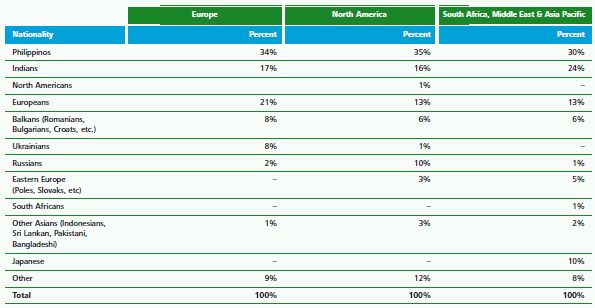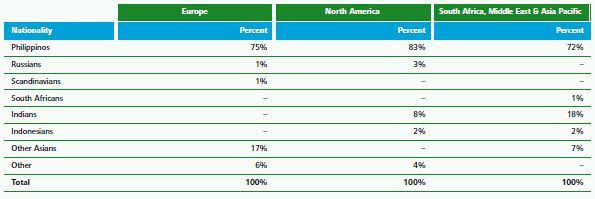FOREWORD
The International Maritime Organization declared 2010 the 'Year of the Seafarer'.
The International Maritime Organization declared 2010 the "Year of the Seafarer." With this in mind, it was timely that we examined a growing concern that many companies in the shipping industry now face – the ability to recruit and retain sufficient numbers of skilled seafarers to staff and operate their vessels. Based on discussions with officials in the maritime sector as well as with executives of various shipping companies, the shortage of qualified, well-trained officers and crew is an issue that has become evident over the last five years and is expected to become one of the most significant problems that the industry must address, not only in countries with well-established shipping industries, such as in Europe and North America, but also on a worldwide basis. In fact, many would argue that it is the single most important issue, given the significance of shipping and transport to the global economy and the critical role of skilled crews in ensuring the safety of their vessels.
The shipping industry is central to the global economy, annually transporting goods – oil and gas, food stuffs and commodities, manufactured products for import and export – that account for approximately 90 percent of world trade. The global fleet of merchant ships is registered in over 150 countries and operated by more than one million crew members of all nationalities.
Skilled and experienced crews are essential to the successful operation of today's technologically advanced vessels. As a result, this growing shortage of qualified seafarers could have a dramatic impact even when considered from just one perspective – the safe operation of a vessel. Since some 80-90 percent of accidents can be ascribed to human error, it is critical that seafarers be well-educated, able to follow orders, manage risks and solve problems.
With this in mind, we present this 'thumbnail' sketch of some of the challenges that shipping companies must address in recruiting and retaining skilled officers and crew, as well as some thoughts on actions that the industry can take to address them.
This report could not have been written without the participation of the many shipping professionals who generously shared their time and perspectives with us, with special thanks to the President and Directors of the Hellenic Chamber of Shipping for their valuable contributions to this work.
George D. Cambanis
Global Leader, Shipping & Ports Practice
METHODOLOGY

|
We surveyed shipping companies around the world to get a better appreciation for how they are managing their crewing needs. In this spirit, questions were asked to ascertain the following: average number of crew employed on vessels, employment of cadets on board, nationalities of the officers and ratings, average age, crew turnover rate, average salaries, a description of training institutions and courses taught and the main difficulties faced by shipping companies. Twenty-three companies responded, representing 1,125 vessels. We have grouped the results into three regions: North America, Europe and Middle East, South Africa and Asia Pacific region. |
OVERALL FINDINGS
Responses from shipping companies confirmed that crewing vessels with competent seafarers is a growing global problem and that crewing is high on the list of business issues for all shipping companies. The global fleet has far outgrown the supply of trained seafarers, with an especially acute shortage of trained officers.
The results of the survey show that the Philippines and India provide approximately 45 percent of the officers and 90 percent of the ratings. This phenomenon can be attributed to a number of factors including the development of marine training institutions, the absence of more attractive employment opportunities in these countries and the good English language skills prevalent among these populations.
Officers are compensated significantly higher than ratings due to the more demanding educational requirements they must satisfy and the greater responsibility they bear for the safe operation of a seagoing vessel.
The shipping industry is striving to make a career in the filed more attractive to young people, but faces numerous challenges including the separation from friends and family while at sea, the desire of 'Generation Y' to be socially networked at all times, the perception that a career in shipping involves a life at sea as well as the recent negative focus on shipping due to environmental issues and piracy, among others.
It came as no surprise that women are vastly underrepresented in a profession that entails much time away from home. In addition, the quality of marine educations varies significantly by country, lacking universal degree standards so that educations are readily recognized across borders. Shipping companies use a mix of recruiting methods, depending on the circumstances and region. To promote growth in the supply of skilled crew members, companies and governments will need to make the profession more attractive. Governments will need to implement innovative incentives and tax rationalization programs and companies will face rising compensation and social benefits packages.
When all is said and done, we are optimistic that there is much that governments and the industry can do to encourage the growth in supply of skilled seafarers.
The crew pipeline
The growth of fleets has outpaced the supply of crews for most shipping companies in Europe, North America and other regions around the globe. In response, shipping companies have found it necessary to seek crews outside of their own countries to meet their needs.
Most vessels require a crew of 20-25 personnel consisting of officers (master, first engineer), specialist technicians (electricians, mechanics), and lower level crews or "ratings" (deck hands, cooks, and oilers).
The average age of officers ranges between 35 and 45 years old as the training and experience required for promotion to the positions of chief officer or chief engineer is at least 10 years.
Countries that have national crew requirements can calculate how many students should enter and graduate from the merchant marine academies each year so that their numbers satisfy their crew requirements in the next decade. This calculation is based on numerous factors that affect the supply and demand of seafarers including:
- number of vessels in fleet;
- number of vessels to be delivered in the future;
- average age of seafarers;
- duration of mandatory training and seafaring experience;
- universities and career drop-rate statistics; and
- average number of consecutive months on board.
Crew size varies according to vessel
Crew size depends on the size and complexity of the vessel. For instance, since VLCCs entail more complex operations, they may require a larger crew. In addition, one to two cadets may be onboard vessels for training purposes.

Crew composition and compensation
On an average vessel with 23 crew members, officers typically represent about 35-40 percent of the crew. In general, wages for tanker officers are higher than those on bulk carriers, a reflection of the higher certification requirements and quality standards that they must satisfy.
Key officer categories and salaries
Compensation of officers is considerably higher than that of ratings for a number of reasons. Their training is far more rigorous, with a minimum three to four years of study required to complete a bachelor's degree.
In addition, once onboard ship, they shoulder a very high level of responsibility for the safe operation of the vessel. In contrast, ratings do not follow a full cycle of education and are not eligible for promotion to officer without a bachelor's degree. Their training is more oriented to short seminars that focus on enhancing safety at sea, while officers' training is dedicated to the technical and managerial aspects of operating a vessel.

Key ratings categories and salaries

Flag state requirements and crew nationalities
The International Convention for the Safety of Life at Sea (SOLAS) requirements and safe manning indicate crew composition in terms of the number, nationalities and qualifications of crew members. Requirements that specify the national composition of crew members can constrain the shipping companies' ability to staff their vessels effectively.
In Greece, for instance, the Ministry of Merchant Marine specifies the number of Greeks that must be employed onboard a vessel, depending on the type of vessel and its technical specifications. For example, Greek flag vessels above 45,000 but below 80,000 dwt require that five Greeks and one cadet be onboard. The master of the vessel must be Greek, with the remaining Greeks employed as officers or ratings.
Norway's manning requirements, in contrast, only specify that the master of the vessel hold Norwegian citizenship, with no restrictions in employing non- Norwegian seafarers to fulfill other roles.
The tables that follow indicate the crew nationalities for officers and ratings of those responding to our survey and give a sense of the countries that are current sources of trained seafarers.
Principal nationalities: officers
The Philippines and India supply more officers to the world fleet than any other country. This can be attributed to several factors: these countries have made significant commitments to establish institutions to provide marine education, their populations have a good command of the English language and, lastly, there is an absence of alternative employment opportunities within their borders.

Principal nationalities: ratings
Perhaps the most striking fact is the absence of Europeans working as ratings on vessels. One explanation is that the European economies are more established so that their citizens have different cultural orientations and employment expectations than workers coming from emerging economies where work opportunities are scarce. As such, European workers tend to pursue the more ambitious officer status and its well-defined, and better compensated, career path.

Career prospects: image of the shipping profession
In spite of the increased compensation and excellent career prospects that the shipping industry offers, young adults harbor numerous concerns when considering shipping as a potential career. These concerns are roadblocks to enticing young people to consider the profession. To cite one example, the Maritime Forum Norway took action and launched an educational campaign targeting 15-19 year-olds to get them to consider a marine education and life at sea. Over three years, the campaign entitled 'Ikke for Alle' – 'Not for all,' an education that can take you a long way – increased applications to marine educational programs by 40 percent! Still, concerns among young people when considering the shipping profession can be attributed to several sociological and financial factors.
In contemporary society, separation from families and friends is less acceptable. Whereas the pain of separation was once offset by the opportunity to travel and visit exotic places, these opportunities have all but disappeared as ships now only make short calls in port – often for only 24-36 hours – or indeed remain outside the port for their commercial operations, compared to some years ago when stays could range from one week to 10 days, leaving more time for crew members to get a break from life at sea.
In response, shipping companies have adopted an employment practice in which consecutive months at sea have been significantly reduced, such as the approximately four to six months for crews of tankers.
Young people (Generation Y) also live in an advanced IT environment where they make extensive use of social networking applications such as Facebook, Skype and Twitter – social platforms that existing technologies on vessels do not always support. In response to this concern, large companies have installed internet connections on their vessels using VSAT technology.
Young people (Generation Y) also live in an advanced IT environment where they make extensive use of social networking applications such as Facebook, Skype and Twitter – social platforms that existing technologies on vessels do not always support. In response to this concern, large companies have installed internet connections on their vessels using VSAT technology.
The industry's ability to provide financial rewards and career longevity also remain concerns as the media consistently promotes more glamorous professions where money comes easily and the living is good. Young recruits compare these professions to years at sea with uncertain prospects for the future when they move ashore. It is not surprising that the shipping profession comes up short. The industry is working to counter this perception by building awareness of career opportunities in a wide range of activities for officers making the transition from life at sea. Among the possibilities are insurance, economics, maritime law, operations, crewing, environmental and safety, among others.
Finally, the recent negative publicity the industry has generated related to safety, environmental protection, social responsibility, legal matters and criminalizing individuals before they stand trial, are all serious deterrents to a career at sea. Seafarers have also been jailed in the absence of criminal intent. Some seafarers are now willing to be paid less to avoid travel through sea lanes where piracy is rampant or demand increased remuneration and guards on board to do so. It is therefore not unreasonable for young people to conclude that there are easier ways to make a living!
Role of women as crew members
While women constitute some 50 percent of the world's talent pool, the industry is clearly not tapping this human resource. Currently, the global marine industry does not employ women onboard tankers and dry bulk carriers, effectively reducing the pipeline of potential seafarers. Women are better represented in the cruise industry and in land-based positions in the shipping industry. This clearly speaks to a lifestyle choice as women balance their family needs with professional decisions. This was consistent with the results of our sample that indicated one woman employed as a nurse onboard a European vessel and three employed on a South African carrier. In Asia and the Middle East, there were no instances of female crew members reported.
Education: gateway to the seafarers pipeline
Access to a quality marine education is an important factor that influences, and can limit, the pipeline of future seafarers. This important factor in the pipeline of seafarers still lacks close and consistent collaboration between academic institutions and the end users of their products, namely the shipping companies that employ their graduates, to ensure that they receive educations that are relevant to the industry. In addition, there is a need for greater standardization of programs and credentials in various countries so that degrees and graduates are accepted across borders.
At present, there are numerous sources and levels of education. Universities in countries such as the UK and the US offer educational programs geared for executives of shipping companies and officers onboard ships. Some nations, including Georgia and others from the former Soviet Bloc, support naval academies where shipping companies recruit officers.
Countries, such as the Philippines and India, have established technical colleges for training technicians and lower level crews. Major shipping companies have also developed their own dedicated training centers or have established manning offices in these countries to gain direct access to potential crews. In addition, independent manning companies in these countries provide crew recruiting services to shipping clients worldwide.
Countries in which marine training is controlled by the state or where private training centers are not allowed by law tend to face the most serious shortages of available seafarers. In contrast, countries that encourage the private sector to develop marine training facilities, such as the Philippines and India, are the leading providers of seafarers to the industry.
Many large shipping companies supplement the academic training of their employees through dedicated training centers equipped with expensive technology and advanced simulators or through seminars offered by some of the well-established protection and indemnity (P&I) clubs, classification societies and specialized computer-based training (CBT) companies.
In addition to the ability to pursue a marine education, a key concern in preparing qualified seafarers is the ability to obtain a high-quality education. As technology rapidly transforms the shipping industry, educational institutions must continue to make considerable investments to ensure that their programs are current and relevant, or risk falling behind. While marine programs in established countries in Europe, for example, rely on legacy programs, newer programs in the emerging markets are leapfrogging ahead in their training capabilities with top-flight simulators and the latest technologies. As an example, Greece's national merchant marine academies were once considered among the best in the industry.
More recently, however, their quality has suffered as a result of insufficient investments to update the curriculum, provide training via simulators and other supporting technologies, support time on modern vessels to gain first-hand experience with current technologies, and generally enhance the transfer of knowledge to the current generation, despite Greece's leading role in the shipping industry.
Also, since many modern vessels do not have the space to accommodate cadets onboard, it is becoming more difficult for novice seafarers to gain real-life crewing experience. As a result, much of the teaching still focuses on the theoretical aspects of the profession rather than encouraging a more practical orientation.
Compounding the challenges of obtaining a quality education, the living conditions at some of the merchant marine academies, many of which are managed like boarding schools and can resemble basic military living conditions, are not appealing and act as a deterrent to students who might consider a marine education.
Finding crew members: current recruiting practices
Growing competition in the industry, coupled with an economic environment in which freight and hire rates are depressed so that margins are squeezed, pose significant concerns to ship owners who see their crewing costs rising. In response, many shipping companies have focused their efforts on recruiting staff in the Far East and Balkan markets where they can find well-trained personnel at a lower cost. Still, these markets are not a panacea for fulfilling recruitment goals as the training and competency of officers from various parts of the world is not consistent and thus must be assessed against the industry's standards. For example, Chinese seafarers frequently have considerable difficulty communicating in English, a prerequisite for operating effectively in international shipping. Romanian, Greek, Norwegian, British, Danish, Ukrainian and Bulgarian seafarers have good skills but are in short supply. While Indians communicate well in English, there are very few maritime schools in India in contrast to the total population.
Currently, only the Philippines remains the largest market for crewing, advantaged by the fact that these people communicate very well in English. The maritime profession is very attractive in the Philippines due to numerous factors including the country's geographical position consisting of approximately 7,100 islands, high unemployment rate, and the population growth rate.
In addition to the decision of where to focus the company's recruiting efforts geographically, one of the most common dilemmas shipping companies face is whether to outsource the crewing of their vessels or to support a crewing recruitment staff within their own companies. While maintaining an internal recruiting function enables companies to exert greater control over the recruiting process as well as to enhance their reputation as an employer, this is a more expensive option that requires significant investment.
Based on the responses of 16 European shipping companies to our survey, that employ a total of more than 9,000 seafarers, our findings indicate that:
- 63% have an in-house department for recruiting seafarers.
- 19% use manning agents.
- 19% are recruiting officers themselves and also enlist manning agents when recruiting abroad primarily.
Larger shipping companies, in Europe and in North America, employ their own in-house global manning agencies rather than use third party manning agencies to recruit their crews. These in-house manning agencies often have global reach which facilitates the company's international recruiting efforts while providing easier access to in-house training facilities on a global basis.
In South Africa and the Middle East, third party manning agencies established in the Philippines, Romania, Pakistan, Croatia and Poland are often enlisted to recruit seafarers from these countries.
In Asia, a combination of third party agencies and in-house expertise is employed, depending on whether they recruit crew members in countries where they do not have established offices. To illustrate, Philippine companies tend to work with third-party manning agents while Japanese companies tend to rely on in-house recruiting departments.
Tax relief: another incentive for crew members
Many countries committed to fostering robust shipping industries within their borders have implemented favorable tax laws, both for seafarers and for shipping companies flying under their home flag.
One example is Italy, where fully exempt tax credits have been implemented for amounts withheld by shipping companies for seafarers employed onboard Italian registered ships in addition to total relief from contributions for the social protection of these seafarers. As a result, effective personal taxation for seafarers has been reduced to zero. The benefit is granted directly and entirely to employers and covers both the quota of social contributions borne by the seafarers and the quota of social contributions borne by the employer.
In Denmark, by comparison, tax incentives are used to reduce manning costs with the seafarer being generally exempted from paying income tax on the Danish International Ship Register (DIS) salary. As a consequence, collective agreements or individual contracts of agreement are able to set wages as net wages.
Tomorrow's crews: best and worst practices in growing the seafarers pipeline
We initiated this survey with the perspective that, while the growing shortage of qualified seafarers will have a dramatic impact on global shipping activity if left unchecked, the global shipping community has the power and vision to implement positive measures that can alleviate, if not resolve, this imbalance between the supply and demand of skilled seafarers. With this in mind, we list below some of the best and worst practices that we encountered in conducting this survey.
Practices that encourage careers in shipping
- Practical learning is favored over theoretical learning in marine degree programs, with access to current simulation technologies and opportunities to obtain work experience serving as a cadet.
- Governments that make significant investments in establishing and supporting educational and training programs.
- Certificates from maritime universities and academies that are recognized as equivalent to bachelor degrees.
- Career paths have been identified and developed in, for example, banking, insurance, law, and operations, to increase professional mobility and enable experienced seafarers to transition back on shore upon reaching a certain level of age and experience, or for specified periods during their commitment.
- Living conditions have been upgraded onboard vessels, including provision of VSAT technologies.
- Personal taxation has been reduced or effectively eliminated on seafarers' income.
- Social benefits for employees, such as compensation for illness and coverage of repatriation expenses, have been enhanced.
- Partial coverage of the social security contributions is provided by the government.
- Standards of Training, Certification, and Watch-keeping (STCW)
certificates are recognized in other countries.
|
The Danish model The perception that a career in shipping requires committing oneself to a life at sea deters many young people from considering shipping as a profession. To address this situation, Denmark developed a model to make the profession more attractive. In brief, officers who have achieved the levels of master or chief engineer, typically having accumulated experience of more than 10 or 15 years at sea, are eligible to pursue various marine-related qualifications (in insurance, maritime law, and finance, for instance) at recognized Danish universities with no additional costs or entry requirements. The objective is to give young people considering a career in shipping some perspectives on the various career paths they can pursue, after they have reached a certain level of experience and would like to retire from active duty at sea. |
Drawbacks that impact the ability of shipping companies to attract better crews
- Favoritism toward national crews when their wages are set above international norms – and those of fellow crew members. This should only be done in instances where the quality, qualifications and innovative thinking of crew members justify higher wages.
- Hostile tax environments that impose high income taxes on seafarers.
- Complex social security schemes for seafarers, such as increased contributions for social security.
- Outdated training programs and educational methods.
- Severe flag state restrictions on crew composition based on nationalities and sex.
- Increased protectionism and governmental intervention, including government prohibitions on private training facilities and strict manning quotas that favor nationals.
- Inability of seafarers to communicate effectively in English due to lack of education.
THE TIME IS NOW: WHAT CAN BE DONE TO ENHANCE THE CREW PIPELINE
Actions need to be taken on numerous fronts to encourage the recruitment and retention of young people to the shipping profession and tip the supply of seafarers in a positive direction. The industry's challenge is to prioritize these actions in light of the considerable financial resources, political will, and collaboration that is required. In closing, we list some possible actions:
- On the 'macro' level, trade organizations and other industry groups could invest in public awareness campaigns to improve the industry's image, particularly on issues related to social responsibility and environmental regulations, and to build a greater awareness of the profession among young people. At the company or 'micro' level, organizations should focus on strengthening their image or 'brand,' communicating corporate culture and core values, and demonstrating respect for human capital, that is, the officers and crew that operate their vessels.
- Enhance access to quality marine education by encouraging a partnership of the public and private sectors and encouraging active participation of the global shipping community. Requirements for admission should be upgraded. Education should be practice-oriented and enhanced by current technologies and simulators. It should also be supplemented by more onboard training opportunities. In addition, maritime training credentials should be more broadly recognized by other countries.
- Expand maritime curricula to meet the needs of individuals operating in a complex global environment, incorporating courses in decision-making, ethics, multi-cultural relations and foreign languages.
- Companies should invest in identifying and developing more defined career paths for their employees including more professional options for experienced seafarers that will enable them to transition successfully to life on shore after fulfilling their commitment at sea.
- Adopt latest human resources management techniques to better understand the needs of seafarers.
- Enhance compensation and social benefits programs of seafarers. Ensure that compensation packages are consistent with international norms related to compensation, social benefits and training.
- Ensure that tax obligations are rationalized for seafarers.
- Introduce greater flexibility on national requirements for crew composition with the goal of achieving a 'transnational' crew that operates cohesively and independently of nationalities. Corporate identity and culture should take precedence over nationalities so that crew members act as "one team."
The content of this article is intended to provide a general guide to the subject matter. Specialist advice should be sought about your specific circumstances.

